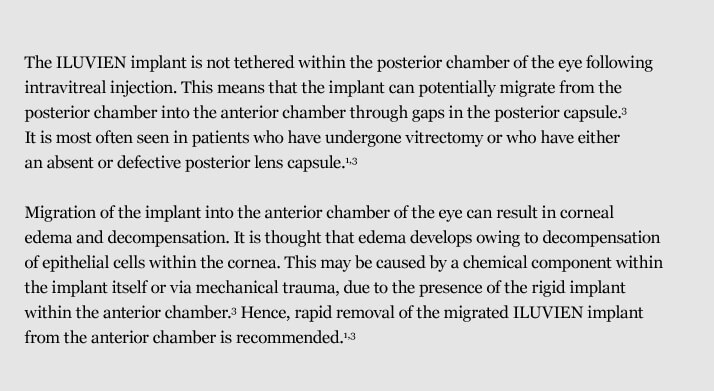
Advertisement feature; Mr Ibraheem El-Ghrably presents ILUVIEN removal and reinsertion in an abstract at RCOphth 2015
Funded by Alimera Sciences. Contains promotional information. Please click here to view the prescribing information and adverse event reporting information.
An abstract presented at The Royal College of Ophthalmologists (RCOphth) Annual Congress 2015 —held at the Arena and Convention Centre, Liverpool, UK, from 19th—21st May—describes a novel technique, in two patients, used to reposition an ILUVIEN® implant (190 µg, intravitreal fluocinolone acetonide, Alimera Sciences), which had migrated into the anterior chamber of the eye, due to an existing tear in the posterior capsule.1,2 The abstract details how the same ILUVIEN implant was removed from the anterior chamber and then reinserted into the vitreous cavity, without compromising the implant’s integrity.1
Ibraheem El-Ghrably, author of the RCOphth abstract, entitled “A novel technique for removal of migrated ILUVIEN implant into the anterior chamber”, describes their technique for removing an anterior chamber-migrated ILUVIEN implant. This involves making an initial side port incision with a keratome, following which an anterior chamber maintainer is introduced and secured. A corneal incision is next made at the 12 o’clock position, through which a 23-gauge backflush needle (ie, a flute needle) is inserted. The needle is gently advanced into the anterior chamber and passive suction used to secure the ILUVIEN implant.1
To reinsert ILUVIEN within the vitreous cavity, without compromising the implant’s integrity, the flute needle is placed through the defect in the posterior capsule, and the exit port blocked. This leads to a loss of suction, allowing the implant to fall into the posterior segment. Finally, the sulcus intraocular lens is centralized, by manipulating it through approximately 180 degrees, to provide adequate support of the anterior capsule.1
Using this technique, the authors report that ILUVIEN implants have been successfully removed from the anterior chamber and reinserted into the vitreous cavity in two patients, without damage or complication to either the eye or implant. In both patients, intraocular lenses were repositioned to close the gap in the posterior capsule. The ILUVIEN implants have remained in the vitreous cavity through two months of follow-up in the first patient and through four months in the second patient.1
Observations from these two patients suggest that this technique for removal and reinsertion of an anterior chamber-migrated ILUVIEN implant is not only easily accomplished, but also appears to be well tolerated and have successful outcomes.

If you would like to learn more about Ibraheem El-Grabley’s case experiences, please click on the following link to access his case presentations from Alimera’s Virtual Grand Round. http://www.events4healthcare.com/alimera_sciences/webinar21042015.html
Please follow this link to access presentations delivered at the Alimera Sciences symposium at RCOphth 2015 http://www.events4healthcare.com/alimera_sciences/rco18052015.html
Look out for DME content developed by Alimera Sciences on this website throughout 2015. We hope it supports your knowledge of DME and ILUVIEN, and if you would like to contribute material for publication, please send your materials to dmecontenthub@hayward.co.uk, we’d be very happy to consider your contributions.
REFERENCES
1. I El-Grably. “A novel technique for removal of migrated Iluvien implant into the anterior chamber”. Abstract presented at The Royal College of Ophthalmologists Annual Congress, Liverpool, 19-21 May 2015.
2. Royal College of Ophthalmologists. Welcome from the Chairman of the Scientific Committee. 2015. Available at http://www.wordsbureausystems.co.uk/RCO2015WEB/index.htm (Accessed May 2015)
3. R Khurana, “How to manage a migrating dexamethasone implant”. Retina Specialist. March 2015. 30-33.
UK-ILV-MMM-0231
Date of preparation: May 2015
Founded in 2003, Alimera Sciences researches and develops innovative vision-improving treatments for chronic retinal disease. Alimera Sciences has developed and licensed ILUVIEN®, an intravitreal implant of 190 micrograms fluocinolone acetonide, for the treatment of vision impairment associated with chronic diabetic macular edema (DME), considered insufficiently responsive to available therapies.a ILUVIEN is the first DME treatment to deliver up to 36 months of continuous, low-dose corticosteroid by single injection.b In 2015, Alimera Sciences has partnered with The Ophthalmologist to facilitate the publication of independently created content on ILUVIEN and DME. Content will range from conference reports, case studies, and literature reviews to video interviews, presentations, and practical information surrounding the use and benefits of ILUVIEN. The word Alimera derives loosely from the Greek, to mean “day of truth”.c With a commitment to honesty, integrity, responsibility, candor, and trust, Alimera Sciences intend that this promotional information accurately and fairly represents the current state of knowledge of ILUVIEN and DME, and is useful to all healthcare professionals involved in DME and its treatment. a. ILUVIEN SPC. 2013 Available at: www.medicines.org.uk/emc/medicine/27636 (Accessed March 2015) b. Alimera Sciences. Available at www.alimerasciences.com (Accessed March 2015) c. Retina Today. 2011. Available at: http://retinatoday.com/pdfs/0111RT_Wall.Street.pdf (Accessed March 2015) UK-ILV-MMM-0167 Date of preparation: March 2015 www.alimerasciences.com enquiries@alimerasciences.com

